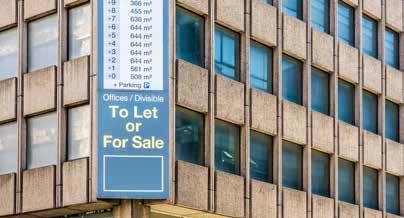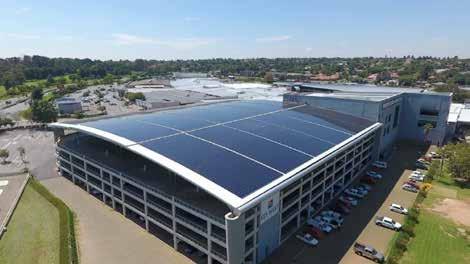
7 minute read
INSIGHTS
An industry check-up
Industry leaders share their market outlook for the commercial property sector. By GARETH GRIFFITHS
Our business leaders believe the work from home novelty will wear off by year end.

Vacancy rates are expected to reach double digits this COVID-19 in a structurally sound manner year according to FNB economist, John Loos. for its entire value chain, playing a pivotal have data released that can show the extent of role in supporting vulnerable small businesses and protecting jobs. Vacancy rates - climbing? “The pandemic has brought forward phenomenon affect occupancies on an Norman Raad, CEO of Broll Auctions the correction to an overvalued ongoing basis, creating further vacancies? and Sales, believes that the commercial property market was overvalued. “Vacancies have increased across the commercial sector.” –CEO Broll Auctions and Sales Norman Raad, Despite its initial appeal, Rob Kane, the CEO of Boxwood Property Fund believes that the novelty of working from home board and the property sector was already is wearing off. “City centres have been struggling as businesses started to Loos expects vacancy rates to reach around for many thousands of years consider consolidation, or were looking for double-digits this year, on the back of a and it is unlikely that the pandemic will smaller, cost-effective premises. sharp GDP contraction forecast of 8 per destroy peoples’ need to congregate to do
Since the (COVID-19) pandemic, some cent for 2020 as a whole. “In addition, the business. We estimate that by year end, businesses have not reopened, making MSCI All Property Vacancy Rate recorded people will have learned to live with the it difficult to calculate increases in 6.7 per cent last year and rose in 2018 presence of COVID-19 and business will vacancies. “The pandemic has brought and 2019 due to the multi-year economic continue,” he adds. forward the correction to an overvalued growth stagnation.” commercial sector, I believe. The Estienne de Klerk, the CEO of Rental growth pressures disparity between new developments Growthpoint, one of South Africa’s largest Loos believes there is a sure recipe for and existing properties has increased real estate investment full-blown rental value drastically, slowing the demand for new trusts (REITs), adds that decline. “Rode’s national developments. Commercial offices were the country entered prime industrial rental already experiencing massive reversions the COVID-19 pandemic inflation y/y was at and increased vacancies before the with a surplus of +0.7 per cent, by the pandemic. The pandemic has just commercial property second quarter, while exacerbated it,” says Raad. space in the market. national decentralised John Loos, an economist However, he sees a A-grade office rentals for Commercial Property possible silver lining to were already in slight Finance at FNB agrees that the clouds for a sector deflation of -0.7 per cent. it is too early to calculate that he believes has come John Loos These saw significant vacancy rates: “We don’t through the initial shock of declines in prior quarters. › Will the working from home lockdown the impact of recent DID YOU KNOW? lockdowns, and the As an alternative to commercial lenders, developers have sought funding from massive likely drop Development Finance Institutions (DFI’S), who tend to have a different risk appetite in GDP in the than commercial banks. While commercial banks prefer to fund post completion second quarter, – effectively “taking out” any development risk - DFI’s have been willing to look at on the commercial development opportunities that have a social as well as a financial impact. property sector.” Source: JLL, Hotel Devt Outlook, 202.

Therefore I expect it is realistic that both, along with retail rentals, will be more significantly negative from H2 2020 into 2021,” he adds.
Notwithstanding the “now”, De Klerk however believes that property has always been a longterm investment: “Rental growth has been inhibited recently because other costs that make up a business’s total cost of occupancy have been subject to hefty increases, including electricity and the alarmingly high rates and taxes increases. “Our tenants must Rob Kane reduce these costs in order to sustain their businesses. Bringing down operational costs is an ongoing focus area for Growthpoint. We have been investing in solar power and other technology to offer a lower cost of occupancy, while also supporting business continuity with back-up power and water.”
Kane adds that those buildings that offer value for money, regardless of their grading, will retain their tenants.
“This massive hit has been difficult for even the most astute property developer or landlord. The lacklustre economy simply doesn’t support any sort of annual escalation. This won’t be good for property owners, who rely on the compounded escalations to repay their investments over a period, and understanding what lies ahead fears most investors and business owners the most,” Raad warns.
Depreciation in capital
De Klerk is bullish about the industrial sector: “Industrial property, and more specifically warehouse/ logistics, proved to be the most resilient of the sectors pre-pandemic.
“There could be an increase in direct investment as interest rates are at an unprecedented low.” – Norman Raad, CEO, Broll Auctions and Sales
The property sector is entrepreneurial, making it naturally agile and positioning it well for a recovery when economic conditions improve.
“Our office portfolio has been its best performer since the lockdown in March due to supportive bluechip clients.” Raad feels that property will always be a sector to invest in. “There could be an increase in direct investment as interest rates are at an unprecedented low. Returns, if backed by a solid tenant, could be financially attractive over the next few years.” “When one looks at the quality of some of the funds and their forward yields, there is definitely value to be had for investors,” agrees Kane.
What is the market outlook?
As an economist, Loos expects the best part of a 15-20 per cent decline in average capital value of all commercial property through this year and next year, adding that full price corrections lag an economic shock due to market resistance to drop values.
Pessimistically, he predicts: “Towards 2022/23, I expect the real value gradual decline to resume, meaning low-value growth not keeping pace with general economic inflation, as the economy returns to its long-term stagnant ways, constrained by many structural problems.”
Raad agrees, adding that there is no short-term solution. “The country as a whole would need to turn this tanker around, which is very close to hitting an iceberg.” “Our biggest threat is corruption and at the expense of repeating many people, the president needs to stop talking and actually put some people behind bars,” suggests Kane.
Kane says that positive meetings have been held between Cape Town City, Wesgro, Provincial Government and Metro Police to discuss how to stimulate recovery together in the City of Cape Town CBD.
“Shortly we will host a business think tank to find practical, immediate and longer-term solutions. You may recall how quickly things were done prior to the World Cup 2010,” reasons Kane.
TARGETED FISCAL STIMULUS
“Start with a reduction in rates. Commercial tenants are usually responsible for the rates and utilities and these have increased, increasing the burden on business. Electricity needs to be reliable and affordable. It has increased over the years to unaffordable levels, without consistency of supply. Investment into small businesses through these concessions is the easiest way to create stimulus,” suggests Raad.
De Klerk comments that, while the South African REIT Association has approached the Treasury for some regulatory relief to enable members to retain earnings without losing their status, to date the National Treasury and the municipalities have not financially assisted the property sector directly.
However, adds Kane: “National, provincial and local governments can all do a lot to remove red tape and stimulate business. The actions needed are not difficult - just ask any competent business person - they will tell you.”
“Short-term fiscal stimulus measures have been massive, and interest rate cuts have been aggressive. But the only real solution to SA’s long-term growth stagnation is those well-documented structural reforms that are desperately needed,” concludes Loos.

Warehousing and logistics property has proved the most resilient sector prior to and during the lockdown period.








